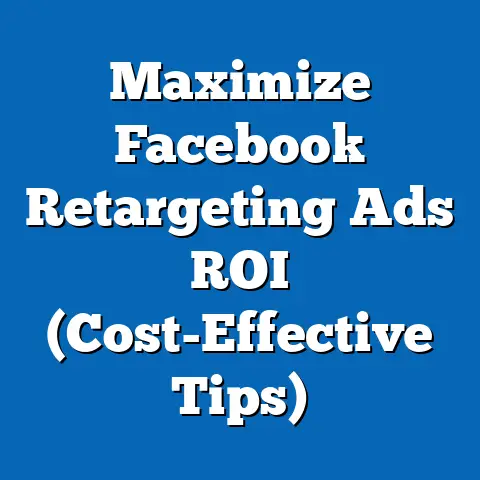Revamp Privacy Policy for Facebook Ads (Essential Tips)
Did you know that over 70% of consumers are more likely to trust a brand that is transparent about its data collection practices? This statistic isn’t just a number; it’s a wake-up call for businesses leveraging Facebook Ads. In an era where data privacy is paramount, a well-crafted privacy policy is no longer optional – it’s essential for building trust, ensuring compliance, and ultimately, boosting your advertising performance. I’ve seen firsthand how a clear and concise privacy policy can dramatically improve user engagement and campaign success. Let’s dive deep into how you can revamp your privacy policy to meet the demands of today’s data-conscious consumers and the ever-evolving landscape of privacy regulations.
Understanding Privacy Policies in the Context of Facebook Ads
Before we jump into the nitty-gritty of revamping your privacy policy, let’s establish a solid foundation. What exactly is a privacy policy, and why is it so crucial, especially when you’re running Facebook Ads?
What is a Privacy Policy?
A privacy policy is a legal document that explains how an organization collects, uses, discloses, and manages the personal information of its users or customers. Think of it as a contract between your business and your audience, outlining the terms of how you handle their data. It’s not just about ticking a compliance box; it’s about building trust and demonstrating respect for your users’ privacy.
Why is it Important for Digital Marketing?
In digital marketing, particularly with platforms like Facebook, data is the lifeblood. We use data to target our ads, personalize experiences, and measure the effectiveness of our campaigns. However, this data-driven approach comes with a significant responsibility: to handle user data ethically and transparently. A well-crafted privacy policy achieves this by:
- Building Trust: Transparency about data practices fosters trust with your audience. When users feel informed and in control of their data, they’re more likely to engage with your brand.
- Ensuring Compliance: Numerous regulations, such as GDPR (General Data Protection Regulation) in Europe and CCPA (California Consumer Privacy Act) in the US, mandate that businesses have a clear and comprehensive privacy policy. Failure to comply can result in hefty fines and reputational damage.
- Improving Ad Performance: Surprisingly, a strong privacy policy can positively impact ad performance. Users are more likely to interact with ads from brands they trust, leading to higher click-through rates and conversion rates.
- Protecting Your Business: A robust privacy policy helps protect your business from legal challenges and negative publicity related to data breaches or privacy violations.
Regulations Affecting Facebook Ads
Facebook Ads operate within a complex web of international and regional privacy regulations. Understanding these regulations is crucial for ensuring compliance and avoiding costly penalties. Here are some of the most important ones:
- GDPR (General Data Protection Regulation): This EU regulation applies to any organization that processes the personal data of individuals within the European Economic Area (EEA), regardless of where the organization is located. GDPR requires businesses to obtain explicit consent for data collection, provide users with access to their data, and ensure data security.
- CCPA (California Consumer Privacy Act): This California law grants consumers several rights regarding their personal information, including the right to know what data is being collected, the right to delete their data, and the right to opt-out of the sale of their data. Although it’s a California law, its impact is felt nationwide, as many businesses choose to extend these rights to all their US customers.
- LGPD (Lei Geral de Proteção de Dados): Brazil’s data protection law, similar to GDPR, grants individuals rights over their personal data and imposes obligations on businesses that process this data.
- PIPEDA (Personal Information Protection and Electronic Documents Act): Canada’s federal privacy law governs how private sector organizations collect, use, and disclose personal information in the course of commercial activities.
- Other Regional and National Laws: Many other countries and regions have their own data protection laws, such as the Australian Privacy Principles (APPs) in Australia and the Personal Data Protection Act (PDPA) in Singapore.
My Experience: In my early days of running Facebook Ads, I underestimated the importance of GDPR compliance. I launched a campaign targeting European users without properly obtaining consent for data collection. It wasn’t long before I received a warning from Facebook, and I had to quickly adjust my campaign to comply with GDPR. This experience taught me a valuable lesson: always prioritize data privacy and ensure compliance with all relevant regulations.
How Facebook’s Advertising Model Relies on Data Collection
Facebook’s advertising platform is built on data. The more data Facebook has about its users, the more effectively it can target ads to the right audience. This data collection includes:
- Demographic Information: Age, gender, location, education, and other demographic details.
- Interests and Behaviors: Pages liked, groups joined, events attended, and other activities that indicate user interests and behaviors.
- Website and App Activity: Information collected through the Facebook Pixel and SDK, which tracks user activity on websites and apps outside of Facebook.
- Offline Activity: Data collected from offline sources, such as customer lists and purchase history, which can be uploaded to Facebook for targeting purposes.
Key Takeaway: Understanding the importance of privacy policies and the regulatory landscape is the first step in revamping your approach to Facebook Ads. Stay informed about changes in privacy laws and adapt your strategies accordingly.
Key Components of an Effective Privacy Policy
Now that we understand the why behind privacy policies, let’s delve into the what. What are the essential elements that should be included in your privacy policy to ensure it’s effective, compliant, and trustworthy?
1. Types of Data Collected
Your privacy policy should clearly and comprehensively outline the types of data you collect from users. This includes both personal information and non-personal information.
- Personal Information: This includes any data that can be used to identify an individual, such as:
- Name
- Email address
- Phone number
- Physical address
- Date of birth
- Usernames and passwords
- Financial information (e.g., credit card details)
- Non-Personal Information: This includes data that cannot be used to identify an individual, such as:
- Browsing history
- Device information (e.g., IP address, browser type)
- Operating system
- Demographic data (e.g., age range, gender)
- Aggregated data (e.g., website traffic statistics)
- Name
- Email address
- Phone number
- Physical address
- Date of birth
- Usernames and passwords
- Financial information (e.g., credit card details)
- Browsing history
- Device information (e.g., IP address, browser type)
- Operating system
- Demographic data (e.g., age range, gender)
- Aggregated data (e.g., website traffic statistics)
Example: “We collect the following types of data: your name and email address when you subscribe to our newsletter; your browsing history on our website to personalize your experience; and your device information to optimize our website for your device.”
2. How Data is Used
Transparency about how you use the data you collect is crucial for building trust with your audience. Your privacy policy should clearly explain the purposes for which you use user data, such as:
- Targeting Ads: Using data to show users relevant ads based on their interests, demographics, and behaviors.
- Personalizing User Experiences: Customizing website content, product recommendations, and other user experiences based on individual preferences.
- Improving Products and Services: Analyzing user data to identify areas for improvement in your products and services.
- Communicating with Users: Sending emails, newsletters, and other communications to keep users informed about your products, services, and promotions.
- Performance Tracking: Measuring the effectiveness of your ads and marketing campaigns.
- Legal Compliance: Using data to comply with legal obligations, such as responding to court orders or government requests.
Example: “We use your data to show you ads that are relevant to your interests, personalize your experience on our website, improve our products and services, and communicate with you about our latest promotions.”
3. User Rights Regarding Their Data
GDPR, CCPA, and other privacy regulations grant users certain rights regarding their personal data. Your privacy policy should clearly explain these rights and how users can exercise them. These rights typically include:
- Right to Access: The right to request access to their personal data and receive a copy of it.
- Right to Rectification: The right to correct inaccurate or incomplete personal data.
- Right to Erasure (Right to be Forgotten): The right to request the deletion of their personal data.
- Right to Restrict Processing: The right to limit how their personal data is used.
- Right to Data Portability: The right to receive their personal data in a portable format and transmit it to another organization.
- Right to Object: The right to object to the processing of their personal data for certain purposes, such as direct marketing.
- Right to Withdraw Consent: The right to withdraw their consent to the processing of their personal data at any time.
Example: “You have the right to access, correct, or delete your personal data. You also have the right to object to the processing of your data and to withdraw your consent at any time. To exercise these rights, please contact us at [email protected]”
4. Data Sharing Practices
Your privacy policy should disclose whether you share user data with third parties, and if so, the types of third parties you share data with and the purposes for which you share it. Common third parties include:
- Advertising Partners: Companies that help you target and measure your ads, such as Facebook, Google, and other ad networks.
- Analytics Providers: Companies that help you analyze website traffic and user behavior, such as Google Analytics.
- Payment Processors: Companies that process payments on your behalf, such as PayPal and Stripe.
- Customer Relationship Management (CRM) Systems: Systems that help you manage your customer relationships, such as Salesforce and HubSpot.
- Email Marketing Providers: Companies that help you send email marketing campaigns, such as Mailchimp and Constant Contact.
Example: “We may share your data with our advertising partners, such as Facebook, to show you relevant ads. We also use Google Analytics to analyze website traffic and user behavior. We do not sell your personal data to third parties.”
5. Security Measures
Your privacy policy should describe the security measures you have in place to protect user data from unauthorized access, use, or disclosure. These measures may include:
- Encryption: Encrypting data in transit and at rest to protect it from interception or theft.
- Firewalls: Using firewalls to prevent unauthorized access to your systems.
- Access Controls: Limiting access to user data to authorized personnel only.
- Regular Security Audits: Conducting regular security audits to identify and address vulnerabilities.
- Data Breach Response Plan: Having a plan in place to respond to data breaches and notify affected users.
Example: “We take the security of your data seriously. We use encryption to protect your data in transit and at rest. We also have firewalls and access controls in place to prevent unauthorized access to our systems. We conduct regular security audits to identify and address vulnerabilities.”
My Experience: I once worked with a client who had a lax approach to data security. They didn’t encrypt user data, and their systems were vulnerable to attack. I strongly advised them to implement stronger security measures, and they eventually did. A few months later, they experienced a data breach, but because they had implemented the security measures I recommended, they were able to contain the breach and minimize the damage. This experience reinforced the importance of prioritizing data security.
Key Takeaway: A comprehensive and transparent privacy policy should cover all the essential elements, from the types of data collected to the security measures in place. This builds trust, ensures compliance, and ultimately, improves your ad performance.
Analyzing Current Trends and Challenges
The world of data privacy is constantly evolving, with new regulations, technologies, and consumer expectations emerging all the time. To ensure your privacy policy remains effective, it’s essential to stay informed about current trends and challenges.
Recent Trends in Privacy Regulations
- Increased Enforcement: Privacy regulators are becoming more active in enforcing data protection laws. GDPR fines have been increasing, and CCPA enforcement is also on the rise.
- Focus on Consent: Regulators are placing greater emphasis on obtaining valid consent for data collection. This means that businesses need to be more transparent about their data practices and provide users with clear and easy-to-understand consent mechanisms.
- Cross-Border Data Transfers: The rules governing cross-border data transfers are becoming more complex. The EU-US Privacy Shield, which allowed for the transfer of data between the EU and the US, was invalidated by the European Court of Justice. Businesses now need to rely on other mechanisms, such as Standard Contractual Clauses (SCCs), to transfer data across borders.
- AI and Privacy: The use of artificial intelligence (AI) is raising new privacy concerns. AI algorithms can collect and process vast amounts of data, and they can be used to make decisions that affect individuals’ lives. Regulators are starting to focus on the privacy implications of AI and are developing new rules to govern its use.
Challenges Companies Face When Updating Privacy Policies
- Compliance with Varying International Laws: Navigating the complex web of international privacy laws can be challenging. Businesses need to understand the requirements of each law and ensure that their privacy policy complies with all applicable regulations.
- Keeping Up with Changes: Privacy laws are constantly evolving, and businesses need to stay informed about the latest changes and update their privacy policies accordingly.
- Communicating Changes to Users: Communicating changes to privacy policies to users in a clear and accessible manner can be challenging. Businesses need to ensure that users understand the changes and how they affect their data.
- Balancing Privacy and Business Needs: Balancing the need to protect user privacy with the need to collect data for business purposes can be challenging. Businesses need to find a way to collect data in a responsible and ethical manner while still achieving their business goals.
My Experience: I recently worked with a company that was struggling to comply with GDPR. They had a complex data infrastructure, and it was difficult for them to track where user data was being stored and how it was being used. I helped them implement a data governance framework that allowed them to better understand their data flows and ensure compliance with GDPR. This experience highlighted the importance of having a robust data governance framework in place, especially for companies that handle large amounts of data.
Case Studies of Companies Facing Backlash Due to Inadequate Privacy Policies
- Facebook: Facebook has faced numerous controversies related to its data privacy practices, including the Cambridge Analytica scandal. These controversies have resulted in significant fines and reputational damage.
- Google: Google has also faced scrutiny over its data privacy practices, including its collection and use of location data.
- Equifax: Equifax suffered a massive data breach in 2017 that exposed the personal information of over 147 million people. The company faced significant legal and financial consequences as a result of the breach.
These case studies illustrate the importance of having a strong privacy policy and robust data security measures in place. Failure to protect user data can have serious consequences for businesses.
Key Takeaway: Staying informed about current trends and challenges in data privacy is crucial for ensuring your privacy policy remains effective and compliant. Learn from the mistakes of others and prioritize data privacy in your business practices.
Steps to Revamp Your Privacy Policy for Facebook Ads
Now that we understand the landscape, let’s get practical. Here’s a step-by-step guide on how to effectively revamp your privacy policy for Facebook Ads:
1. Conduct a Thorough Audit of Existing Policies
The first step in revamping your privacy policy is to conduct a thorough audit of your existing policies. This involves reviewing your current privacy policy, data collection practices, and data security measures to identify any gaps or weaknesses.
- Review Your Current Privacy Policy: Read your current privacy policy carefully and identify any areas that are outdated, unclear, or incomplete.
- Assess Your Data Collection Practices: Identify all the types of data you collect from users, how you collect it, and how you use it.
- Evaluate Your Data Security Measures: Assess the security measures you have in place to protect user data from unauthorized access, use, or disclosure.
- Identify Gaps and Weaknesses: Based on your review, identify any gaps or weaknesses in your current policies and practices.
My Experience: I once audited a client’s privacy policy and discovered that it hadn’t been updated in over five years. It didn’t reflect their current data collection practices, and it didn’t comply with GDPR or CCPA. This audit helped them identify the areas they needed to improve and develop a plan to revamp their privacy policy.
2. Consult with Legal Experts to Ensure Compliance
Data privacy laws are complex and constantly evolving. It’s essential to consult with legal experts to ensure that your privacy policy complies with all applicable regulations.
- Hire a Data Privacy Attorney: A data privacy attorney can help you understand the requirements of GDPR, CCPA, and other privacy laws and ensure that your privacy policy complies with these regulations.
- Seek Expert Advice on Specific Issues: If you have questions about specific data privacy issues, such as cross-border data transfers or the use of AI, seek expert advice from a data privacy consultant.
Important Note: While it’s tempting to use free online privacy policy generators, they often lack the specificity and legal expertise needed to ensure compliance. Investing in professional legal advice is a worthwhile investment.
3. Update Data Collection Practices to Reflect New Regulations
Based on your audit and legal advice, update your data collection practices to reflect new regulations and best practices.
- Obtain Explicit Consent: Obtain explicit consent from users for data collection. This means that you need to provide users with clear and easy-to-understand information about your data practices and obtain their affirmative consent before collecting their data.
- Provide Users with Control Over Their Data: Give users control over their data by providing them with the ability to access, correct, or delete their personal data.
- Minimize Data Collection: Collect only the data that is necessary for your business purposes. Avoid collecting data that is not relevant or that you don’t need.
- Implement Data Security Measures: Implement robust data security measures to protect user data from unauthorized access, use, or disclosure.
4. Clearly Communicate Changes to Users in an Accessible Manner
Once you’ve updated your privacy policy, it’s essential to clearly communicate the changes to your users in an accessible manner.
- Use Plain Language: Use plain language that is easy for users to understand. Avoid using legal jargon or technical terms.
- Highlight Key Changes: Highlight the key changes in your privacy policy so that users can quickly understand what’s new.
- Provide a Summary: Provide a summary of your privacy policy that highlights the most important points.
- Use Visuals: Use visuals, such as icons and infographics, to make your privacy policy more engaging and easier to understand.
- Notify Users of Changes: Notify users of changes to your privacy policy via email, website banners, or other means.
My Experience: I once helped a client rewrite their privacy policy using plain language and visuals. The result was a privacy policy that was much easier for users to understand and that increased user trust.
5. Implement Ongoing Reviews to Keep the Policy Current
Data privacy laws are constantly evolving, so it’s essential to implement ongoing reviews to keep your privacy policy current.
- Schedule Regular Reviews: Schedule regular reviews of your privacy policy, at least once a year, to ensure that it reflects the latest regulations and best practices.
- Monitor Changes in Privacy Laws: Monitor changes in privacy laws and update your privacy policy accordingly.
- Seek Feedback from Users: Seek feedback from users on your privacy policy and use their feedback to improve it.
Key Takeaway: Revamping your privacy policy is an ongoing process. By following these steps, you can ensure that your privacy policy remains effective, compliant, and trustworthy.
Best Practices for Communicating Your Privacy Policy
Having a strong privacy policy is only half the battle. You also need to communicate it effectively to your users. Here are some best practices for making your privacy policy easily accessible, transparent, and engaging.
1. Making the Privacy Policy Easily Accessible
- Link Placement: The placement of your privacy policy link is crucial. Make sure it’s easily visible and accessible from all pages of your website and app. Common locations include:
- Website footer
- Account settings page
- Checkout page
- App settings menu
- Mobile Optimization: Ensure that your privacy policy is mobile-friendly and easy to read on small screens.
- Multiple Languages: If you have users in multiple countries, translate your privacy policy into their languages.
- Website footer
- Account settings page
- Checkout page
- App settings menu
My Experience: I’ve seen many websites bury their privacy policy in obscure locations, making it difficult for users to find. This sends a negative message and can erode trust. Make your privacy policy a prominent and accessible part of your website and app.
2. Transparency in Building Trust
Transparency is key to building trust with your audience. Be open and honest about your data practices, and avoid using vague or misleading language.
- Explain Data Practices Clearly: Clearly explain what data you collect, how you use it, and who you share it with.
- Avoid Jargon: Avoid using legal jargon or technical terms that users may not understand. Use plain language that is easy to read and comprehend.
- Be Honest About Data Collection: Don’t try to hide or downplay your data collection practices. Be upfront about what data you collect and why.
- Provide Examples: Provide examples of how you use user data to make your explanations more concrete and understandable.
3. Encouraging Users to Read and Understand the Privacy Policy
Getting users to actually read and understand your privacy policy can be challenging. Here are some methods for encouraging users to engage with your privacy policy:
- Interactive Elements: Use interactive elements, such as quizzes and infographics, to make your privacy policy more engaging.
- Summaries: Provide a summary of your privacy policy that highlights the most important points.
- Layered Approach: Use a layered approach to presenting your privacy policy, starting with a brief overview and then providing more detailed information for users who want to learn more.
- Just-in-Time Notices: Provide just-in-time notices that explain how you’re using data at the moment you’re collecting it. For example, when a user signs up for your newsletter, provide a brief notice explaining how you’ll use their email address.
My Experience: I once worked with a client who created an interactive quiz based on their privacy policy. The quiz tested users’ knowledge of their data privacy rights and provided them with personalized recommendations for protecting their data. This quiz was a huge success and significantly increased user engagement with their privacy policy.
Key Takeaway: Communicating your privacy policy effectively is just as important as having a strong policy in the first place. By making your privacy policy easily accessible, transparent, and engaging, you can build trust with your audience and demonstrate your commitment to data privacy.
The Impact of a Strong Privacy Policy on Facebook Ads Performance
You might be wondering, “Does a strong privacy policy really make a difference to my Facebook Ads performance?” The answer is a resounding yes. A well-structured and communicated privacy policy can have a significant positive impact on your ad performance and user engagement.
Enhancing Ad Performance and User Engagement
- Increased Trust: As mentioned earlier, transparency about data practices fosters trust with your audience. When users trust your brand, they’re more likely to engage with your ads and convert into customers.
- Improved Ad Relevance: By being transparent about how you use data to target ads, you can increase ad relevance and improve click-through rates.
- Higher Conversion Rates: Users are more likely to purchase from brands they trust. A strong privacy policy can increase conversion rates by building trust and confidence in your brand.
- Reduced Ad Fatigue: By being transparent about how you use data, you can reduce ad fatigue and improve the overall user experience.
- Better Brand Reputation: A strong privacy policy can improve your brand reputation and make you more attractive to customers who value data privacy.
My Experience: I’ve seen firsthand how a strong privacy policy can improve Facebook Ads performance. I worked with a client who was struggling to get results from their Facebook Ads campaigns. After revamping their privacy policy and communicating it effectively to their audience, they saw a significant increase in click-through rates, conversion rates, and overall ROI.
Correlation Between Privacy Transparency and Customer Loyalty
- Increased Customer Retention: Customers who trust your brand are more likely to remain loyal and continue purchasing from you.
- Positive Word-of-Mouth: Customers who value your commitment to data privacy are more likely to recommend your brand to others.
- Stronger Brand Advocacy: Loyal customers can become brand advocates and help you promote your products and services.
Leveraging Your Privacy Policy as a Marketing Tool
- Highlight Your Commitment to Privacy: Use your privacy policy as an opportunity to highlight your commitment to data privacy and build trust with your audience.
- Differentiate Yourself from Competitors: Use your privacy policy to differentiate yourself from competitors who may not be as transparent or committed to data privacy.
- Showcase Your Data Security Measures: Use your privacy policy to showcase the security measures you have in place to protect user data.
- Promote Your Privacy Policy: Promote your privacy policy on your website, social media channels, and other marketing materials.
Key Takeaway: A strong privacy policy is not just a legal requirement; it’s a marketing asset that can enhance ad performance, build customer loyalty, and differentiate you from competitors.
Conclusion
In today’s data-driven world, revamping your privacy policy for Facebook Ads is not just a compliance exercise; it’s a strategic imperative. As I’ve emphasized throughout this guide, a strong privacy policy not only protects your business from legal repercussions but also fosters trust and loyalty among consumers in an increasingly data-conscious marketplace. By understanding the key components of an effective privacy policy, staying informed about current trends and challenges, and following the steps outlined in this guide, you can ensure that your privacy policy is not only compliant but also a valuable asset for your business. Remember, transparency, accessibility, and engagement are key to building trust with your audience and maximizing the positive impact of your privacy policy on your Facebook Ads performance. So, take the time to revamp your privacy policy, communicate it effectively, and reap the rewards of a more trusting and loyal customer base.






